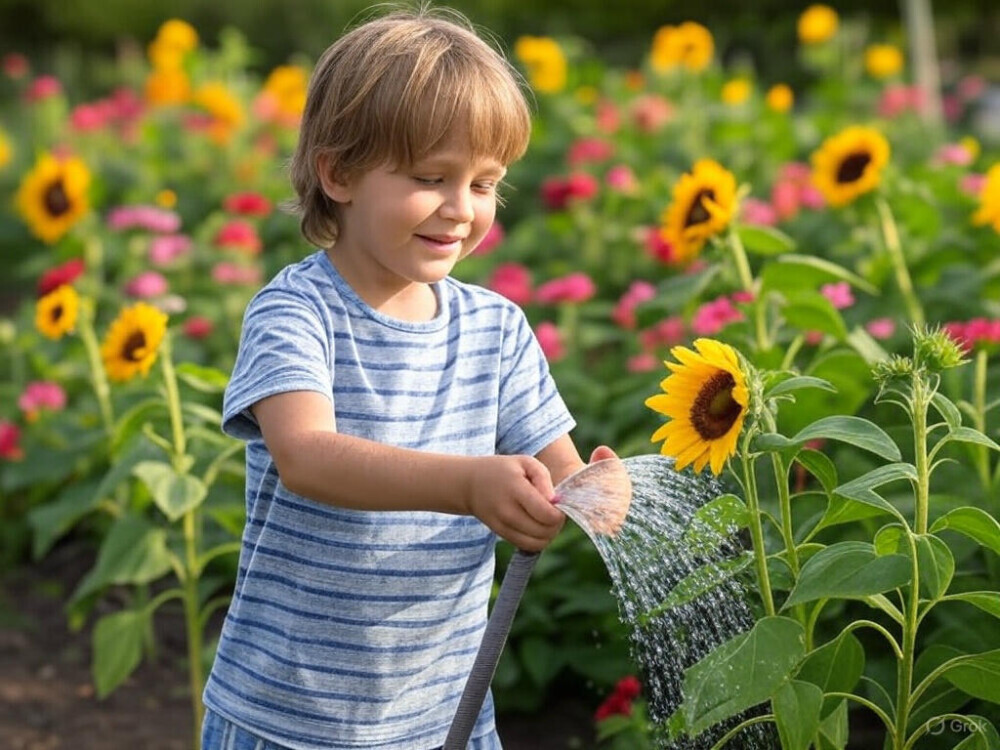
How Planting Sunflowers Can Inspire Learning in Your Child
Gardening is a wonderful way to introduce children to nature, patience, and responsibility. Sunflowers, in particular, are a fantastic choice for young gardeners – they’re easy to grow, quickly reach an awe-inspiring size, and are packed with learning opportunities. As your child watches their sunflower sprout and stretch toward the sky, they’ll be learning valuable lessons about patience, care, and the wonders of nature.
Spring is the perfect time to plant sunflowers, as the gentle warmth and increasing sunlight create ideal growing conditions. Through this simple yet rewarding project, you can help your child explore science and maths, all while fostering a sense of wonder.
Choosing the Right Sunflower Variety
Before getting started, consider which sunflower variety best suits your space.
- Dwarf Sunflowers are perfect for small gardens or container planting. Their compact size makes them easy for young children to care for.
- Giant Sunflowers provide a dramatic impact, often growing several feet tall. Watching them reach impressive heights can be an exciting way for your child to track growth over time.
Planting Sunflowers: Setting Up for Success
Encourage your child to be involved in every step of the planting process – it’s a hands-on lesson in responsibility and patience.
- Choose the Right Spot: Pick a sunny area with well-draining soil. Loosen the soil and mix in some compost for extra nutrients. Alternatively you can sow seeds in a large plant pot.
- Planting the Seeds: Show your child how to plant sunflower seeds about one inch (2.5 cm) deep and six inches (15 cm )apart. A gentle watering will help them settle in.
- Observing Growth: Talk to your child about what the seeds need to sprout – water, sunlight, and time. This is a great opportunity to introduce the basics of plant life cycles.
Caring for Sunflowers: Encouraging Responsibility
Once the sunflowers begin to grow, looking after them will teach your child important lessons about nurturing and responsibility.
- Watering Wisely: Guide your child in keeping the soil moist, explaining that too much or too little water can affect the plant’s health.
- Supporting Growth: If your sunflowers grow particularly tall, they may need some help staying upright. Involve your child in securing them with stakes or twine, reinforcing the idea that plants – like people – sometimes need a helping hand to stand strong.

Measuring Growth: A Fun Maths Activity
Watching sunflowers stretch toward the sky is both exciting and educational. You can turn this process into a simple maths activity:
- Track Weekly Measurements: Provide your child with a tape measure and encourage them to record the sunflower’s height each week. This helps build early maths skills and an understanding of change over time.
- Create a Growth Chart: On graph paper or on a large sheet of cardboard on which you have drawn evenly spaced lines with a ruler, mark height on the vertical axis and weeks on the horizontal. Recording the sunflower’s progress teaches your child about plotting data on graphs and visual representation in a way that feels part of the excitement of seeing the sunflower grow.
Educational Activities & Science Lessons
Gardening naturally connects children to science, and sunflowers present plenty of opportunities for learning.
- Keeping a Sunflower Journal: Encourage your child to write or draw about their sunflower’s progress. They can note weather conditions, new leaves, or pollinators they spot.
- Introducing Photosynthesis: You can even introduce your child to how photosynthesis works: The leaves of the sunflower act like tiny solar panels, soaking up sunlight. This light energy helps the plant turn water from the soil and carbon dioxide from the air into food, giving it the strength to grow tall and produce vibrant yellow blooms. This process – called photosynthesis – is how all plants make their own food. And as a bonus, they release oxygen into the air, helping us breathe! Interestingly, young sunflowers actually follow the sun across the sky in a process called heliotropism – named after the Greek words ‘Helios’ (sun) and ‘tropos’ (turning). Observing how the sunflower moves throughout the day can be a great way for children to understand how plants respond to their environment.
- Pollination in Action: Show your child how bees and butterflies visit the sunflower to collect nectar and spread pollen. Explain how this process helps plants grow and how pollinators play a crucial role in nature.

Harvesting Sunflowers: Completing the Cycle
As the sunflower season comes to an end, there’s one last valuable lesson – harvesting the seeds.
- Collecting Seeds: Teach your child how to carefully remove the seeds from the flower’s centre. Some can be saved for planting next season, while others can be turned into a snack or bird feed.
- Understanding Life Cycles: By gathering the seeds, your child will see firsthand how plants reproduce and how nature provides for both people and animals.
Final Thoughts
Growing sunflowers is not only an enjoyable activity, it’s a valuable learning experience that connects children to the rhythms of nature. Through each stage, your child will gain insights into plant life cycles, science, and responsibility, all while making them aware of the wonders of nature and the world around them. So why not plant some sunflower seeds together and watch as both the flowers and your child’s knowledge grow?
